As the World Golf Hall of Fame celebrates the Class of 2024, here’s a closer look at the LPGA’s forgotten founders
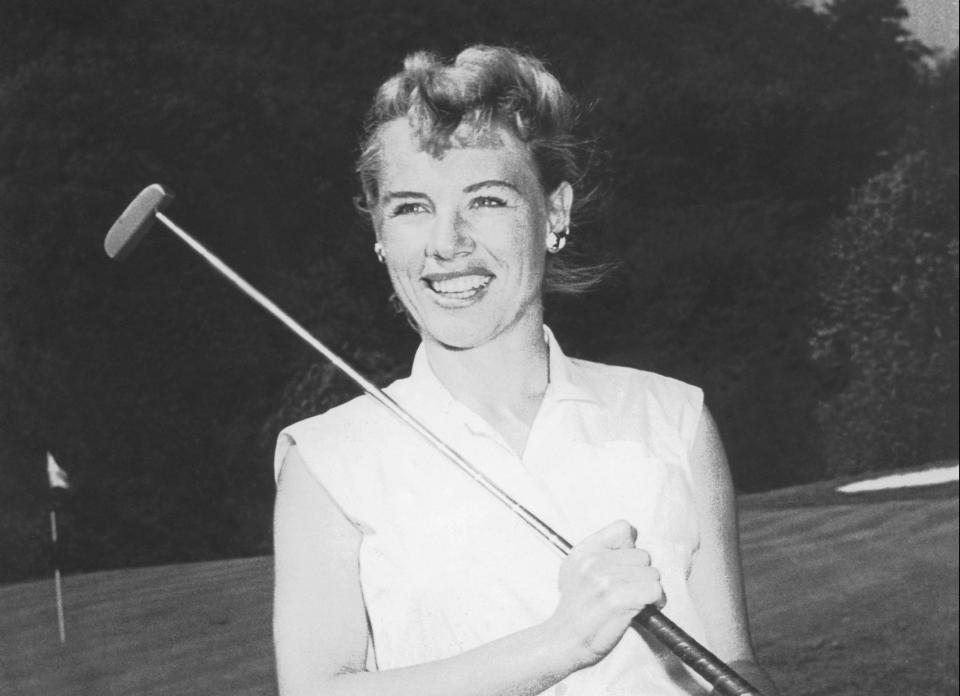
Alice Bauer’s nickname was “sparkle plenty.” Gregarious and bubbly, one of the LPGA’s original glamour girls knew how to play a crowd. One time, daughter Heidi recalled, Bauer did a screen test in Los Angeles and was turned down after being told that said she had no personality.
“Turns out that woman said the very same thing to Lucille Ball!” Heidi said with a laugh.
Alice Bauer never won on the LPGA, but as the elder half of the Bauer sister phenomenon, she was instrumental in helping a fledgling tour find its footing. Younger sister Marlene Bauer, who was just as stylish but more intense, won 26 times on the LPGA. The famed sporting sisters – who were even married to the same man! (at different times) – took distinct paths as Alice raised two children and chose to prioritize family.
“Marlene was very serious,” said Heidi. “She could go out with a migraine and win the tournament. She could compartmentalize.
“My mom would be out there worrying about groceries.”
Marlene was inducted into the World Golf Hall of Fame in 2002. On Monday, Alice will join her, along with six other LPGA founders who never quite got their due.
This is this story of the forgotten founders.
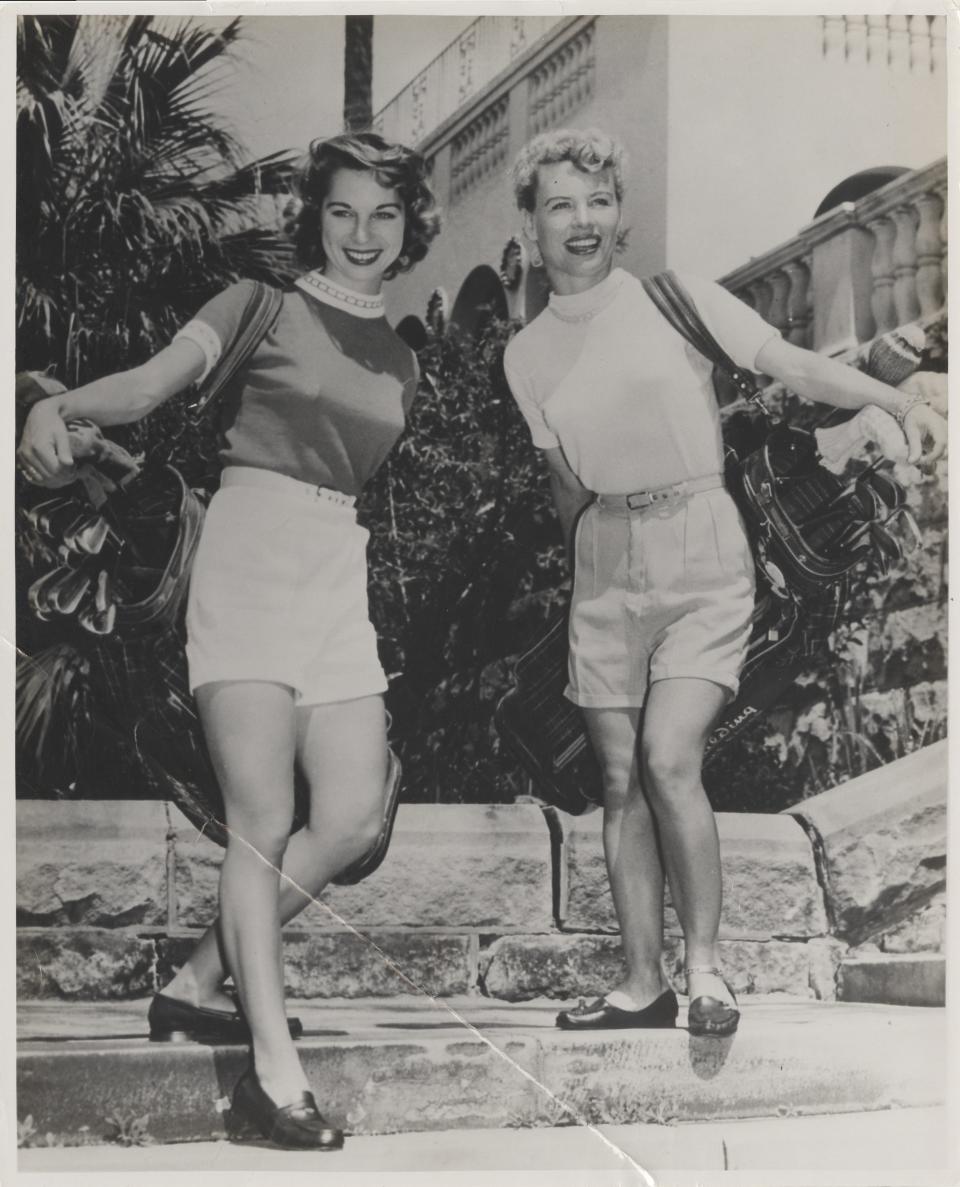
Alice Bauer and Marlene Bauer Hagge (LPGA photo)
***
In Fred Corcoran’s autobiography “Unplayable Lies,” the 13th chapter, aptly titled “The Ladies,” begins with a phone call from Wilson Sporting Goods Company president L.B. Icely. Corcoran had recently signed Olympic sensation Babe Didrickson Zaharias as a client, and Icely wanted to know, if he could get other manufacturers’ on board, would Corcoran run a women’s tour?
In the winter of 1949, Corcoran, who’d been employed by the men’s PGA, found himself in Florida for an organizational meeting that included the likes of Patty Berg, Louise Suggs and the Babe. They had one event lined up in Essex Falls, New Jersey.
There had been a Women’s PGA that had stumbled along for a few years, Corcoran wrote, and he recalled that the charter was held by a pioneering pro, Hope Seignious, and her father. He called them in Greensboro, North Carolina, and asked if they would surrender the charter. They said no.
Corcoran called his attorney, who suggested they call the new organization the Ladies’ PGA.
And so, the LPGA was born.
That first tournament in Essex Falls had six players signed up and a purse of $3,500. Corcoran recalled that Helen Dettweilier called to withdraw before her tee time because her dog was sick and still got paid $350.
It was a quiet start.
“The announcement that we had formed the Ladies’ PGA touched off a national storm of indifference,” Corcoran wrote. “Potential sponsors were polite when I called them, but you could hear them stifling a yawn at the other end of the line.”
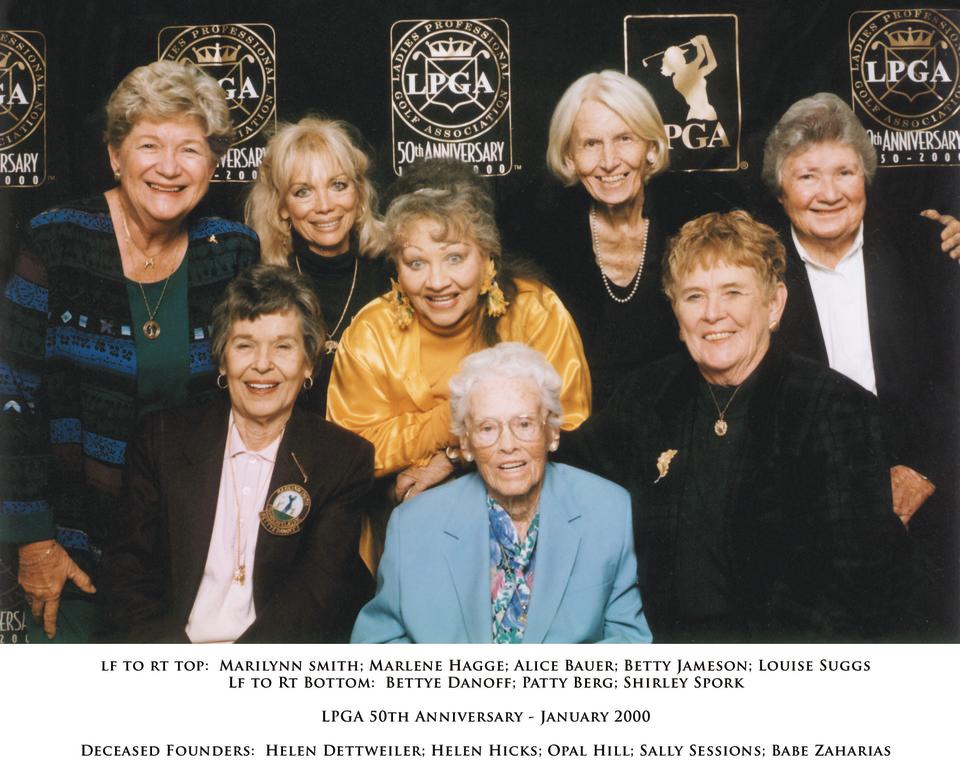
Patty Berg is surrounded by fellow LPGA founders. Top row, left to right, Marilynn Smith, Marlene Hagge, Alice Bauer, Betty Jameson and Louise Suggs. Bottom row, left to right, Bettye Danoff, Berg and Shirley Spork in January 2000 celebrating the LPGA’s 50th anniversary.
As has been the case all along for the LPGA, a man with deep pockets – Alvin Handmacher – rode in to save the day. Corcoran came up with the idea of a progressive tournament and Handmacher, a manufacturer of women’s sports clothes, stepped up to sponsor the Weathervane Transcontinental Tournament, putting up $15,000 in prize money and a $5,000 bonus to the winner. Corcoran noted that Handmacher also spent three times as much promoting the events.
Five women signed the original charter – Betty Jameson, Helen Hicks, Sally Sessions, Berg and Dettweiler – and the LPGA kicked off its inaugural season in 1950.
It was fitting that an amateur, Polly Riley, won the tour’s first event, the Tampa Open, as the LPGA relied on amateurs to fill out its fields. For a time, it wasn’t fashionable to be known as a female professional. They were instead referred to as “business women golfers.”
Berg and Zaharias did much to change that perception. Zaharias won eight of the tour’s 15 events that first season, including the 1950 U.S. Women’s Open, in Wichita, Kansas, where eight more charter members were added: Bettye Danoff, Opal Hill, Marilynn Smith, Shirley Spork, Alice Bauer, Marlene Bauer Hagge, Louise Suggs and Zaharias.
The popular Berg was elected president.
The Hall of Fame of Women’s Golf was established that same year, in 1950. Nearly 75 years later, the 13 brave women who founded the tour will be inducted into the World Golf Hall of Fame under the contributor category. Six founders were already enshrined based on their competitive records.
But the superstars couldn’t have done it alone. They’ll now be joined in the Hall by Alice Bauer, Danoff, Detweiler, Hicks, Hill, Spork and Sessions.
The induction ceremony, which coincides with the 124th U.S Open, will take place June 10, 2024, at Pinehurst Resort & Country Club in the Village of Pinehurst, North Carolina.
Regrettably, all 13 founders will be celebrated posthumously.
***
Shirley Spork had plans to teach and coach at Bowling Green State University while studying for her master’s degree in the fall of 1950. Breakfast with the Babe altered those plans.
Babe needed more pros to play against and encouraged Spork come on board prior to the start of the Chicago Weathervane event at Skycrest Country Club, where Babe was the new head pro.
With a tap on the head and A declaration from Babe – “I now pronounce you a pro” – Spork went down to the first tee with a new career, though she’d continue to teach until landing a sponsor.
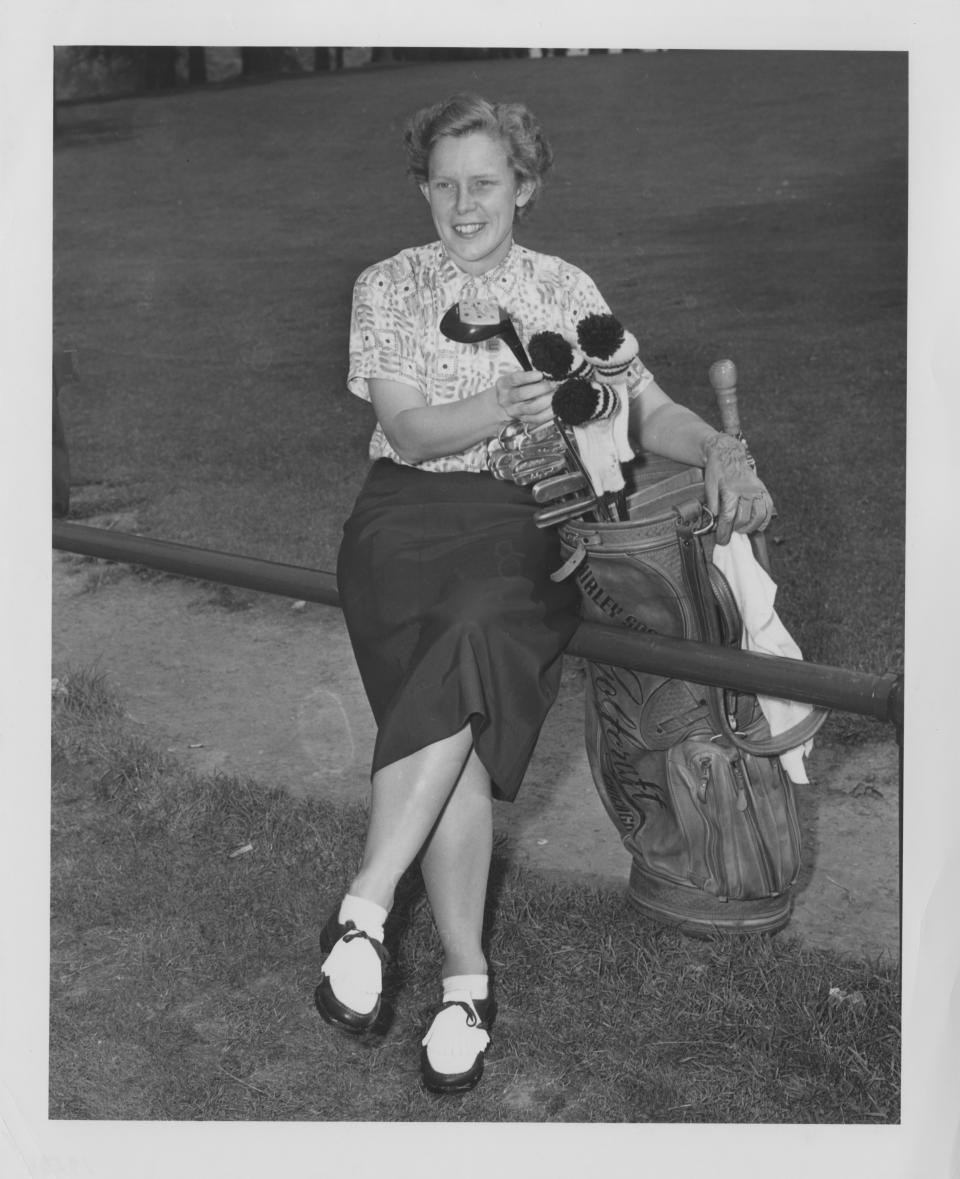
Shirley Spork LPGA
Lifelong friends Spork and Smith traveled the tour together that first year, driving for a few hours before stopping at a town park to play a game of catch with their baseball gloves. That was gym life in those early days.
They tried to stay at motels with kitchenettes as much as possible. Spork noted in her memoir, “From Green to Tee,” that one player had a frying pan, another packed the coffee pot, and Spork carried around a shoebox of spices.
There were no managers or nutritionists or trainers in those early days. Everyone simply looked out for each other and did the best they could. They each had a role to play.
“We ate a lot of canned tuna and liver because the iron was good for our strength,” Spork wrote. “Marilynn had some kind of vitamins she thought everyone should take.”
The money was so poor back then that one time in Waterloo, Iowa, Spork put a check in the collection plate at mass only to have the monsignor send it back along with a note and a church cookbook: “I enjoyed playing in the pro-am with you,” the priest wrote. “You didn’t do so well in the tournament, and I think you need this more than the church does.”
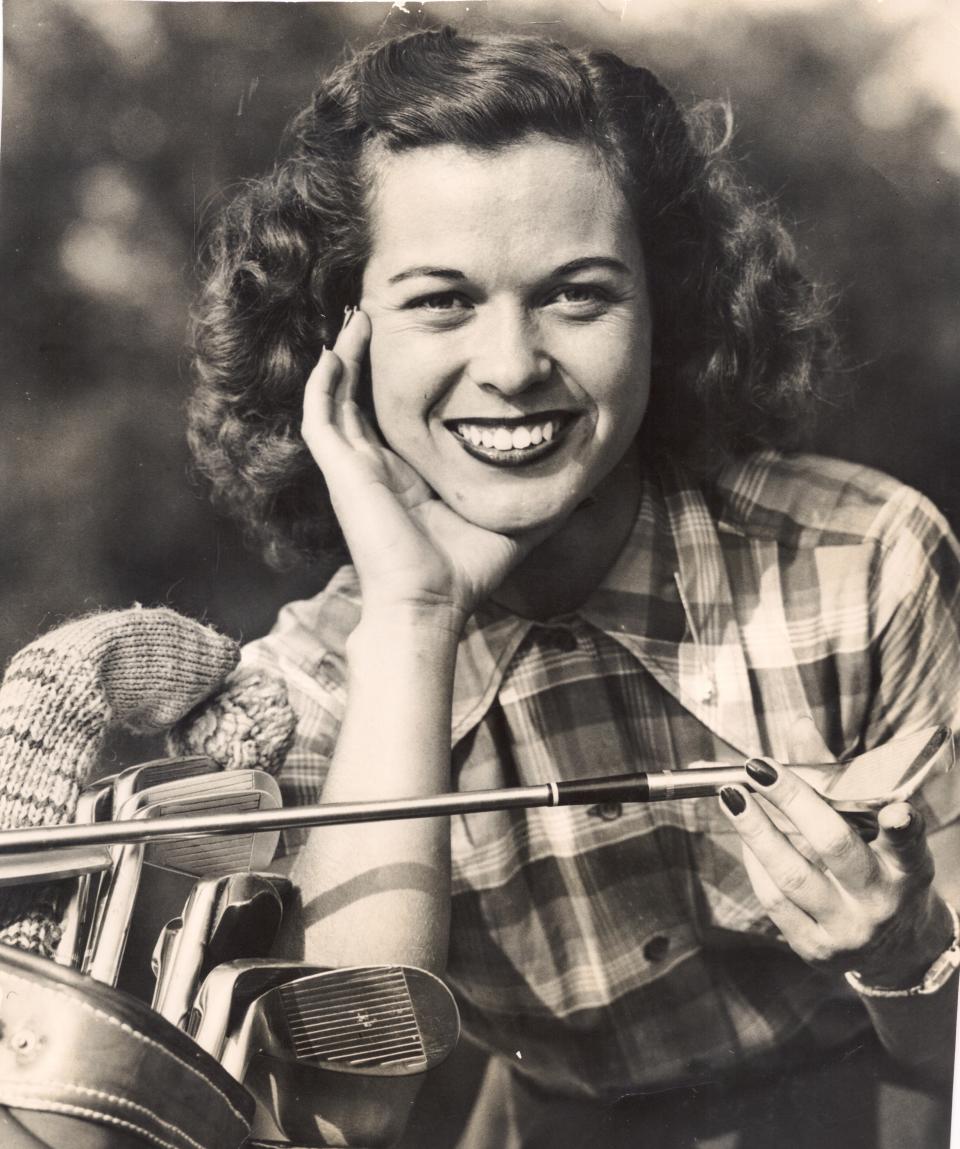
LPGA founder Bettye Danoff poses with her clubs. (courtesy Debbie Bell)
Debbie Bell, the youngest daughter of LPGA founder Bettye Danoff, arrived early into the world in the spring of 1956. Two weeks later, the LPGA rolled into town for the Dallas Open, and Danoff left the hospital to see her friends at Glen Lakes Country Club. It wasn’t long before Danoff called her husband – a physician who’d delivered Debbie – from the club to see if she could play in the tournament. She walked all 72 holes.
“She was ‘Mighty Mite,’ ” said Debbie of the nickname her petite mother carried for hitting the ball so far, though it could obviously extend to other strengths.
A decorated amateur who beat the Babe head-to-head at the 1947 Texas Women’s Open, Danoff played a minimal schedule after her husband died suddenly of a massive heart attack.
Danoff’s presence in those early days, even if limited, was foundational to the tour’s success. Debbie said her mother was sometimes warned for slow play because she spent so much time talking to the gallery.
In 1960, a 37-year-old Danoff was promoted as the tour’s first grandmother after eldest daughter Kaye had a child. In her book, “The Illustrated History of Women’s Golf,” historian Rhonda Glenn chronicles Patty Berg’s popular Swing Parade, when a middle-aged Danoff came out limping with a cane during a pre-tournament clinic, wearing a long black skirt, high-button shoes, a floppy hat, gold-rimmed granny glasses and her hair sprayed gray.
“Her picture, hitting a 3-wood in her absurd get-up, made the front page of the local newspaper the following day,” Glenn wrote.
Putting on a show was always a priority.
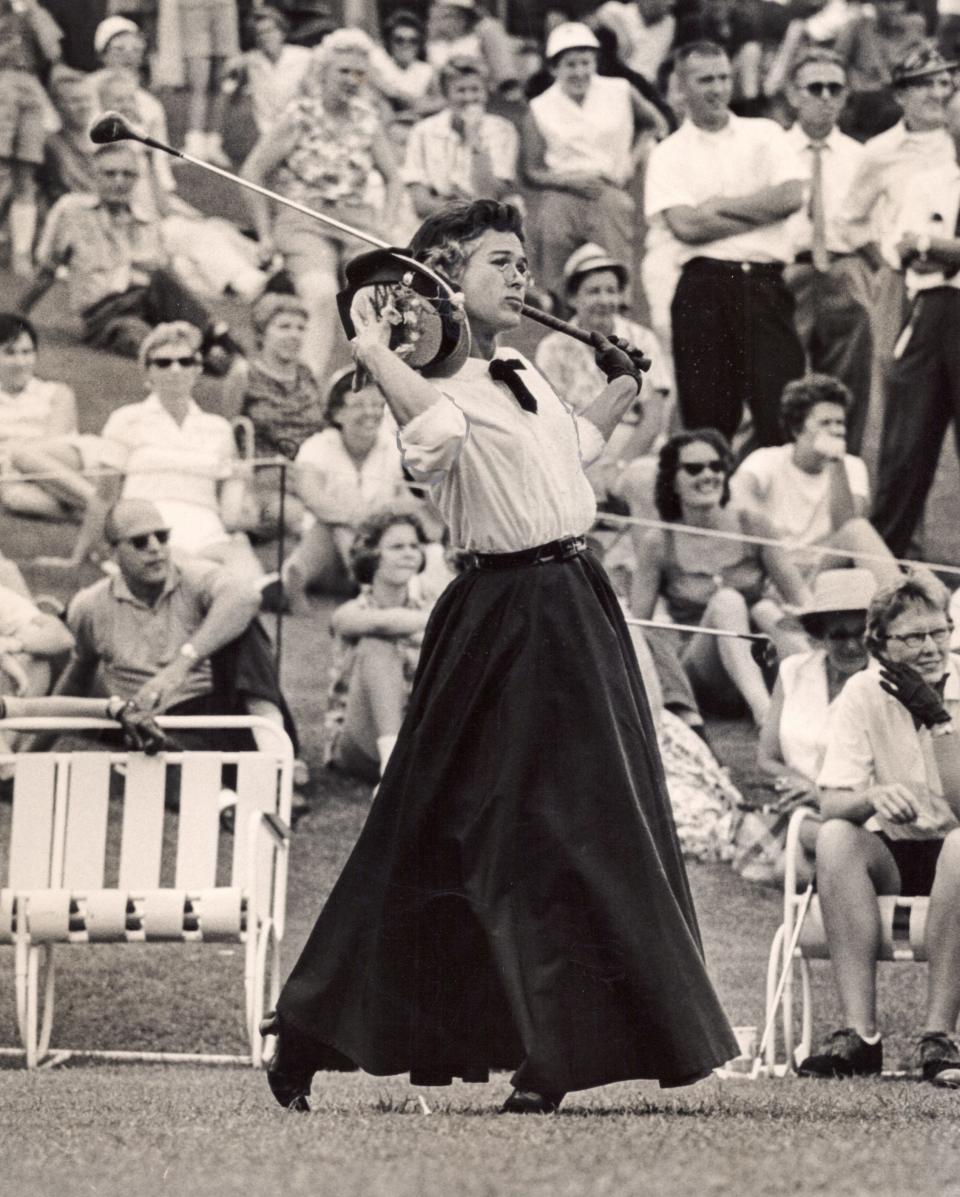
Bettye Danoff, the tour’s first grandmother, dresses the part for a pre-tournament show. (courtesy photo Debbie Bell)
***
English journalist Liz Kahn flew to America in the late 70’s to cover an LPGA event in Florida and lost all her luggage.
“I can remember calling my sports editor and telling him I’m on the bed in a fur coat,” she said with laugh.
Kahn became so intrigued by the women of the tour that she set out to write a book, a massive undertaking that involved dozens of interviews across the country over the span of 15 years. It was a fight, at times, trying to gain access and acceptance, but over time, she gained the trust of many.
“Being a touring woman professional is a tough existence,” Kahn wrote in her introduction to “The LPGA: The Unauthorized Version.”
“Inevitably, the way of life, traveling week in week out, living on a high and in a state of tension, breeds a tight, closed society, friendly to its members and wary of those outside. Their perception is heightened; they are more aware as a group, more constantly tense, emotionally involved. They luxuriate in it, and they are hurt by it.”
In some cases, Kahn became friends with her subjects, as was the case with Dettweiler, an academic who became a pilot during World War II, flying B-17s after she joined the WASPs (Women Air Force Service Pilots). The humble Dettweiler downplayed her service, often saying that the planes flew themselves.
Spork’s book notes that Dettweiler later commanded a staff of women who set up code-breaking operations around the country. Spork called her old friend brilliant.
“She was quite shy,” said Kahn. “She had no ego, really.”
Dettweiler became the third female professional to work for a golf club manufacturer, following in the footsteps of fellow LPGA founders Hicks and Hill. Dettweiler told Kahn that she was a never a great competitor, enjoying the people far more than the competition. Her only professional title was a major, the 1939 Western Open, for which she received no money, only a silver bowl.
After her competitive days were over, Dettweiler became southern California’s first teaching pro, and her client list included President Dwight D. Eisenhower, who had a standing lesson with at 8:30 a.m., except on Sundays. A strong businesswoman, Dettweiler also owned a retail shop on El Paseo in Palm Springs.
In her later years, Dettweiler enjoyed regular trips to Africa, inviting Kahn for one such excursion.
“It’s the one regret in my life,” said Kahn of not being able to go.
Sessions, like Spork, hailed from Michigan and was a state champion tennis player before she took up golf seriously at age 16. She quickly excelled, taking a share of second at the 1947 U.S. Women’s Open while still an amateur.
One of her greatest feats locally, however, was winning the Muskegon city tennis and golf titles on the same day in 1942. In addition to her athletic prowess, she was also an accomplished musician who wrote operas.
The first woman to ever break men’s par with a 69 at Pinehurst Country Club in 1947, Sessions was elected the tour’s first secretary at the organizational meeting in Wichita.
She only competed one year on the LPGA, however, after being diagnosed with leukemia. Sessions went on to teach in the Detroit school system until retiring in February 1966, months before she died at age 43.
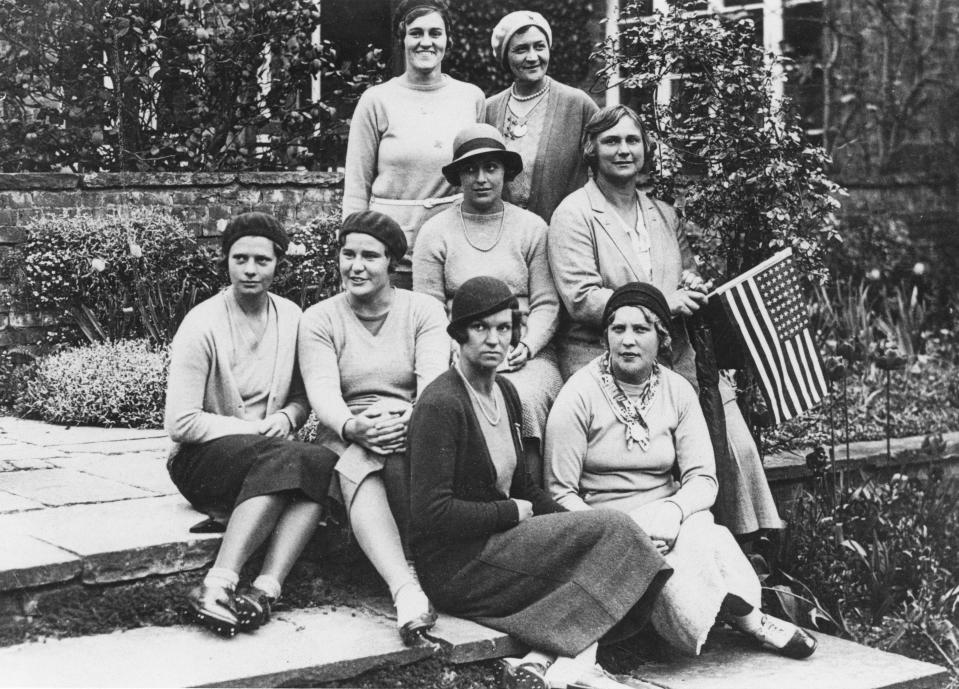
Members of the 1932 U.S. Curtis Cup team, which included at rear: Leona Cheney, Opal Hill. Seated/seccond row, left to right; Glenna Vare, Marion Hollins, Virginia Van Wie and Helen Hicks. Seated at front, Leona Cheney, and Dorothy Higbie. It was the first Curtis Cup Match and was played on May 21, 1932 at Wentworth Golf Club in Virginia Water, Surrey, England. The United States won 5 1/2 to 3 1/2.(Copyright Unknown/USGA Museum)
When Corcoran’s lawyer drew up the papers for the tour in New York, the law stipulated that at least one of the signatures needed to come from a New York resident. That’s how Hicks became a founder, though the Long Islander’a inclusion was no fluke.
A member of the inaugural U.S. Curtis Cup team in 1932, Hicks would later become the first woman hired by a manufacturing company (Wilson) in 1934 to promote its equipment and put on clinics, blazing a trail later popularized by her mentee, Patty Berg.
Hicks won two major titles along the way, the 1937 Women’s Western Open and 1940 Titleholders.
Opal Hill, one of the least-known founders, was 58 when the tour started in 1950 and her bio in the LPGA media says she was considered the “matriarch of women’s golf.” After being told that she only had three years to live due to a lingering kidney infection, Hill took up golf to get the physical activity her doctor advised.
Golf, one could say, saved Hill’s life as she went on to become a two-time Western Open champion, three-time Western Amateur champion and three-time Trans-Miss champ. A member of the USGA Women’s Committee, Hill had a nursing degree and lived in Kansas City, Missouri, with husband Oscar Hill, an attorney.
Like Hicks, she was also part of the inaugural Curtis Cup match, won by the U.S., at Wentworth Golf Club in Surrey.
In her memoir, Spork recalled playing with Hill at the 1951 U.S. Women’s Open in Atlanta and again, several years later, in a National Golf Foundation nine-hole scramble.
“Opal had a putter with a little loft on it,” Spork wrote. “When she putted, the ball hopped up into the air the first foot and a half or so. Then it landed back on the gren and rolled right into the cup. It was something unusual to see. Opal had nine one-putts and our team won! What an experience to watch Opal’s putting style that day; it’s something I’ll never forget.”
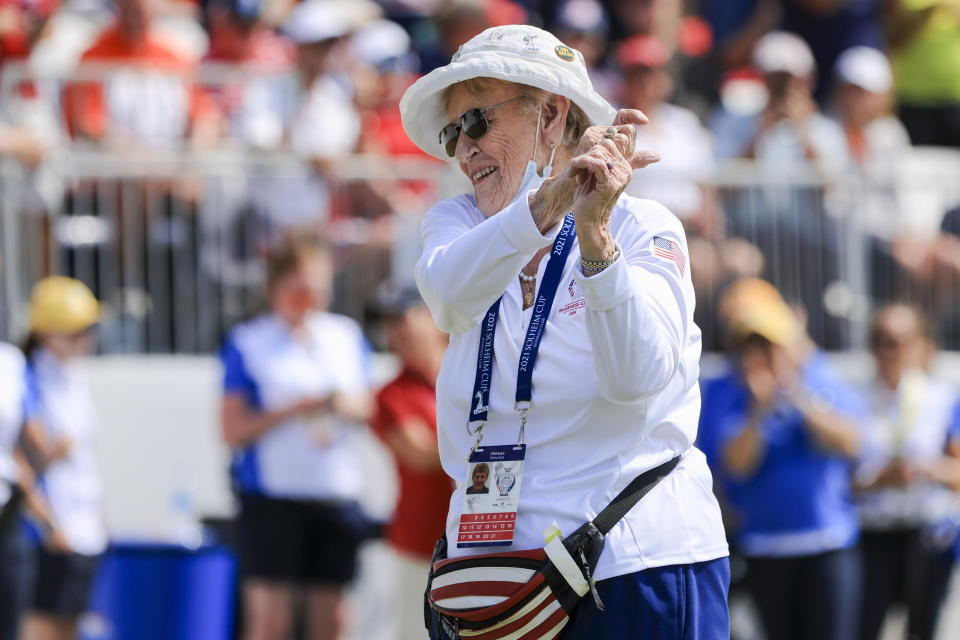
Professional golfer and co-founder of the LPGA Tour, Shirley Spork stands on the first tee box during competition rounds of the Solheim Cup golf tournament at Inverness Club. (Photo: Aaron Doster-USA TODAY Sports)
Carla Glasgow, 80, was 16 years old the first time she saw Spork put on a clinic in Whittier, California. She asked for a lesson that day, and so began a student-teacher relationship that lasted 67 years.
When she was old enough to drive herself to Indian Wells Country Club, Glasgow would get a lesson and play few holes with Spork before going over to her house for dinner. In the evenings, as Glasgow would hit balls into a net in the backyard, Spork would holler instructions out the kitchen window.
Talking golf swing was Spork’s native tongue, and she was the main driver behind the creation of the LPGA Teaching & Club Pro Division, a career path for women that could extend beyond their playing days.
Glasgow, who qualified for the tour in 1972, happened to be staying with Spork in 2022 during the LPGA’s final edition of the old Dinah Shore tournament at Mission Hills Country Club. Spork came home from a meeting at the club early in the week with the news that she’d finally be inducted into the LPGA Hall of Fame, along with the rest of the tour’s founders who’d never made it in.
Two weeks later, Spork died of a heart attack at age 94. She never knew about the World Golf Hall of Fame honor, which was announced the following year.
“It should be clear to everyone that without that effort at that time, the LPGA would not be where it is today,” said Judy Rankin of a tour that’s playing for just under $125 million this season, up 75 percent from three years ago.
Back home on her ranch some 40 miles south of Tucson, Heidi Bauer Gussa reminisced on the time she was named queen of the National Golf Show in New York City as a toddler. With the Babe as her unofficial godmother, Heidi recalled sleeping in the backseat of a car quite often growing up on tour. Raised to be “the third Bauer girl,” Heidi never grew to love the game quite like her mom. After growing up surrounded by celebrities, Heidi retreated to a more rural existence.
In 2002, days after Alice Bauer died of colon cancer, younger sister Marlene went into the LPGA Hall of Fame. Heidi took her mother’s ashes to the ceremony because she’d promised Alice that she’d make it there.
“I do remember sitting in the back of the limousine holding her urn,” said Heidi.
A reminder that Monday’s recognition at Pinehurst comes decades too late for Alice and her contemporaries.
Though few have deserved it more.

 Yahoo Sport
Yahoo Sport 






































